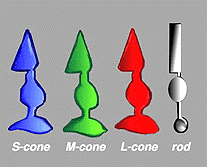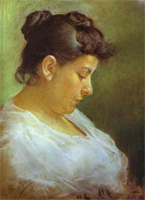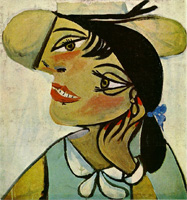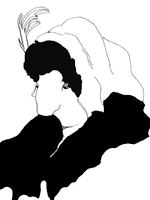 The
eye has two kinds of receptors that respond to light, rods and cones.
The
eye has two kinds of receptors that respond to light, rods and cones.
<- Intro to Visual Communication
home DOWNLOAD:
Assignment 2: Speaking in Shapes
Vision is both a physical and mental activity. The human eye receives light and focuses it on a surface, much like a camera. The image itself is two-dimensional and upside down on the eye's retina, yet our brain interprets it as a right side up image. Actually, since humans have two eyes that face forward, there are two slightly different images that the brain combines to create a 3-D image. This is called binocular vision.
For a detailed explanation of how the eye works, see How Vision Works and/or The Joy of Visual Perception.
 The
eye has two kinds of receptors that respond to light, rods and cones.
The
eye has two kinds of receptors that respond to light, rods and cones.
Rods are sensitive to light levels (how bright is it?). There are about 110 million rods in each eye's receptor, the retina. Rods provide us black and white information, and are essential for night vision, motion detection, and peripheral vision (to the sides). Rods are distributed fairly evenly throughout the retina except for the tiny (2.5-3 mm) central area, the fovea, where there are none. Rods can respond to low intensity light.
Cones are sensitive to color but need greater intensity (brighter) light. There are about 7 million cones in each eye. Each of the three types of cones responds to a specific color/wavelength of light: RED (long), GREEN (medium) and BLUE (short). Cones also provide details, and are packed most tightly in the fovea, where we get the highest resolution image. There are no rods here, meaning that it's hard for us to see detail in low-light situations. This graph shows how rods and cones are distributed in the eye.
The diagram at right, along with actual photos of the eye's rods and cones, and more can be found at the Webvision site. Also, Georgia State University offers more details on rods and cones.
It's interesting to note that televisions and computer monitors use the same three colors, called RGB. We'll learn more about this in Week 7.
When the eye's receptors are overstimulated they get tired, resulting in an afterimage. This is the basis for various optical illusions, like Bird in a Cage and the Herman Grid.
We as humans seems to have a fascination with optical illusions, from Op Art (M.C. Escher, Cleveland's Richard Anuszkiewicz and others) to Magic Eye "3-D" pictures.
Why do you think this is true?
Here's another type of optical illusion you've probably seen:

(from the Mighty Optical Illusions website)
Read the section below and think about how this type of optical illusion might fit with the idea of ambiguity and survival.
The eye takes in light of varying brightness and colors. A pattern is formed on the retina. It's up to the brain to interpret what this pattern actually is. Often there can be a variety of meanings to a pattern, resulting in what's called ambiguity. The brain doesn't like ambiguity. It tries to "make sense" of things, to find order or a recognizable pattern. Why?
In many respects it comes down to one thing: survival. For years, tens of thousands of years, humans depended on vision for three survival needs:
We needed to quickly recognize patterns in the environment: food sources, predators, members of the same species. Actually, even now not much has changed, has it?. A 2006 article describes how blonde hair may have given certain cavewomen an evolutionary advantage over the more common brunettes: Cavegirls were first blondes to have fun.
Given the fact that our visual sense is critical to survival, why do most people prefer—at least at first glance—the painting on the left?


By the way, these portraits were both painted by Pablo Picasso.
We seem to love the challenge of optical illusions, where we think we see one thing that often turns out to be another. In the classic illusion below, do you see a young woman or an old one? Are you sure? Look again.

What does this have to do with survival? What's going on here?
For many more examples, go to the visual
illusions gallery .
[TOP]
From the Preface of A Primer of Visual Literacy by Donis A. Dondis, we get this definition:
Literacy means that a group shares the assigned meaning of a common body of information. [The purposes of visual literacy are] to construct a basic system for learning, recognizing, making, and understanding visual messages that are negotiable by all people, not just those specially trained...
For an excellent introduction to everything covered in this class and much
more, read the book. You can buy it used from Amazon.com
for about 10 bucks.
[TOP]
Everyone in the class was given a set of three geometric shapes:



and asked to pick the one that fit them best.
Which one would you pick?
Which do you think most students picked?
In one class, about 90% picked:

Was that your choice?
In another class the students were about evenly divided in terms of the shapes they picked. There are no right or wrong answers in a test like this. Our choices so say something about how we view ourselves as well as help us begin to develop a visual vocabulary.
Each of us has a set of meanings, based on instinct, education and experience, that we use when we interpret shapes. The society we live in also affects this. I would bet that this same experiment conducted in Japan or China would have somewhat different results than when done in the U.S. or Canada.
There's a somewhat dubious explanation of this called geometric psychology. Here its interpretations of various shapes:
Squares and rectangles are the linear and convergent thinkers. They are logical and rooted in time and space. Circles and squiggly lines are the non-linear and divergent thinkers. They see lots of options and are much less rooted in time and space.
OTHER WEEKS:
WK1 | WK2 | WK3
| WK4 | WK5
| WK6 | WK7
| WK8 | WK9
| WK10 | WK11
| WK12 | WK13
| WK14 | WK15
| WK16